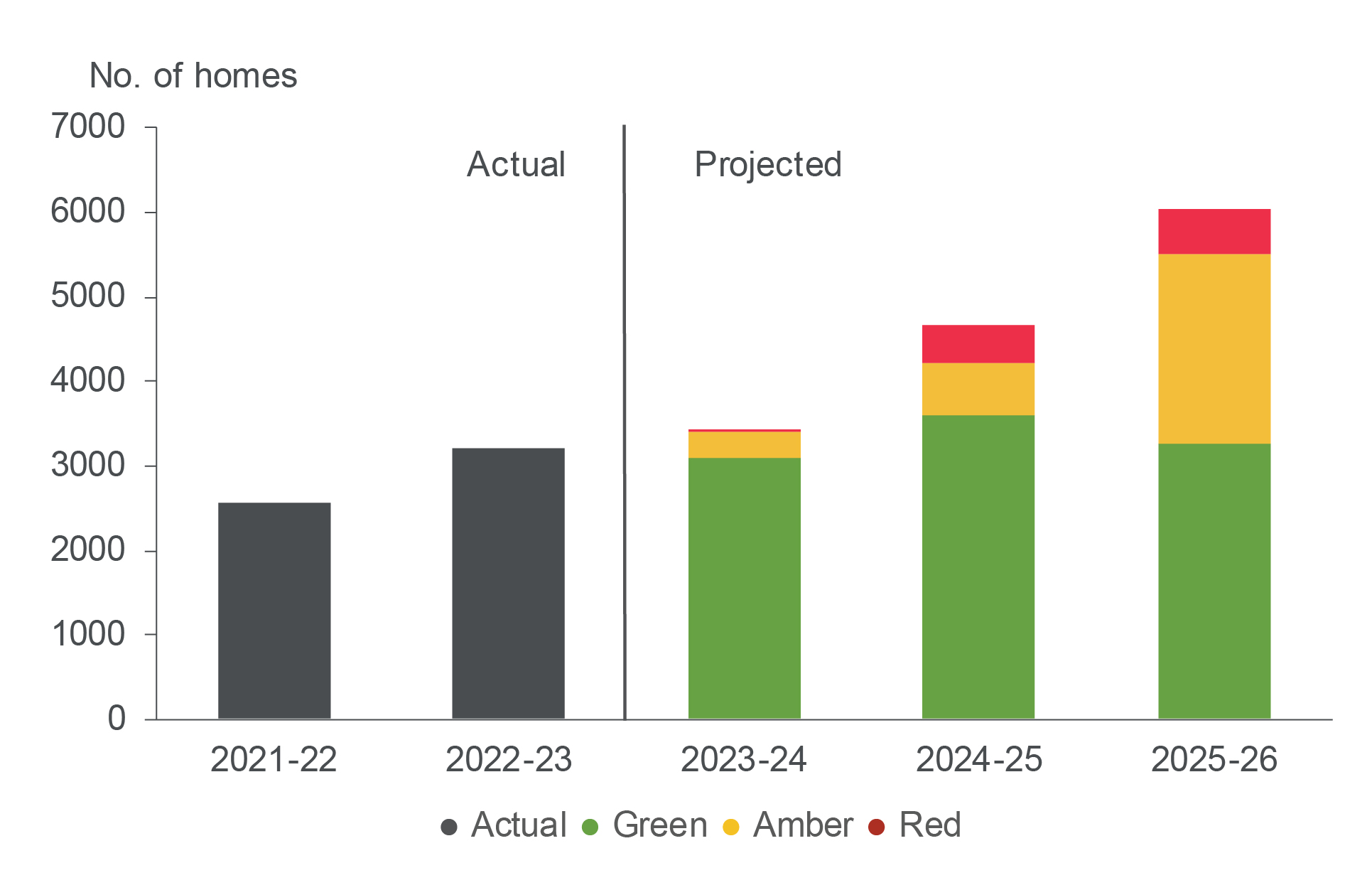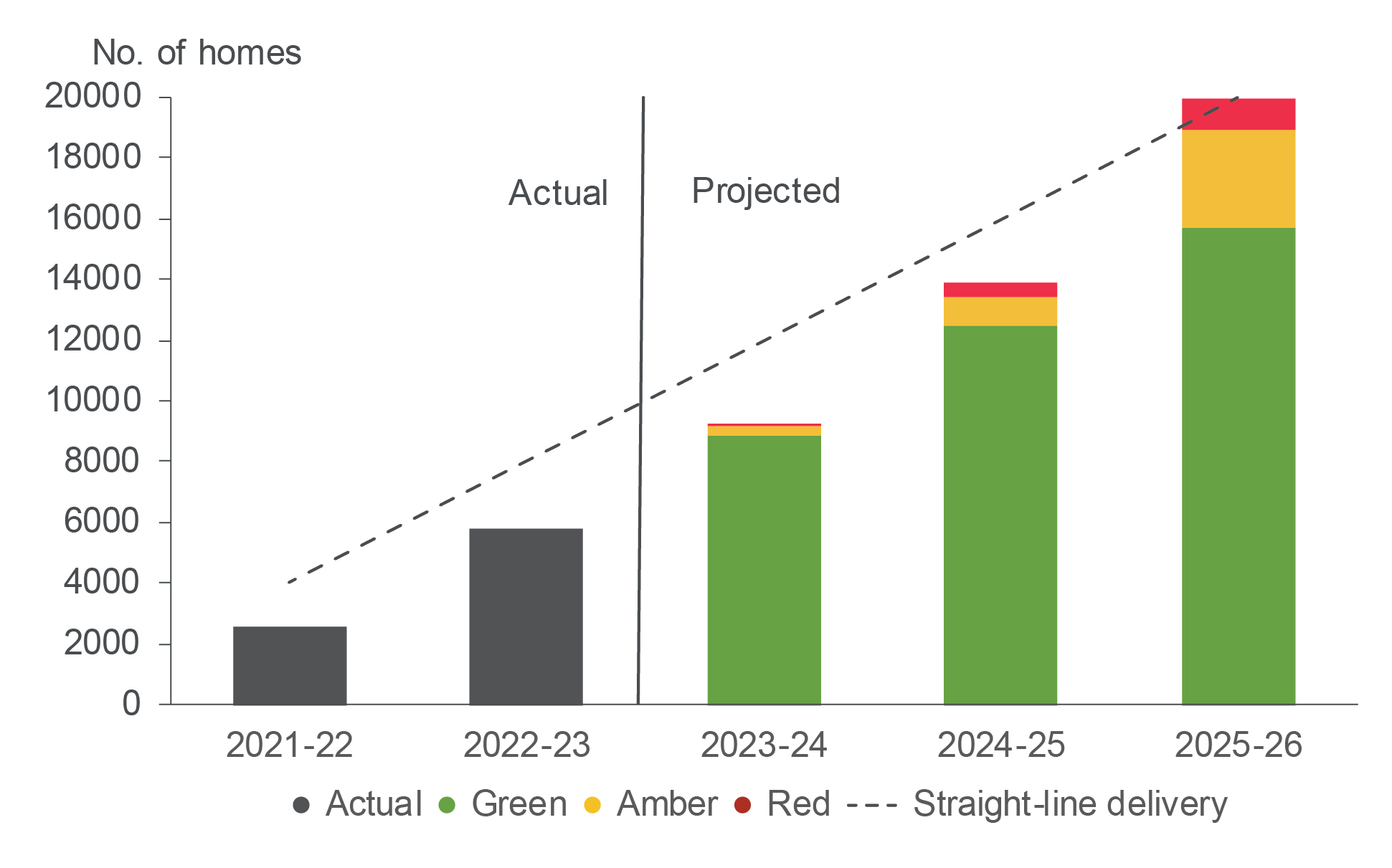Last month Audit Wales published an in-depth review of progress against the delivery of the Welsh Government’s target of 20,000 new low carbon social homes for rent by March 2026. Mark Jeffs presents some of the key messages, especially around the choices the Welsh Government now faces.
What exactly is the target?
 One of the initial tasks for us was to establish exactly what the Welsh Government’s goals are for affordable housing. As auditors looking at value for money, we don’t tell government what it should value. We ask what public good does government want from its policies and spending? We then examine how economically, efficiently and effectively it has used its resources to achieve its goals both now and for the longer-term.
One of the initial tasks for us was to establish exactly what the Welsh Government’s goals are for affordable housing. As auditors looking at value for money, we don’t tell government what it should value. We ask what public good does government want from its policies and spending? We then examine how economically, efficiently and effectively it has used its resources to achieve its goals both now and for the longer-term.
In its Programme for Government, the Welsh Government says it will ‘build 20,000 new low carbon social homes for rent’. While that commitment seems straightforward on paper, in practice it’s more complicated:
Build new? The Programme for Government says ‘build’, but the Welsh Government counts acquisitions – existing homes bought or secured on long-term leases.
Low carbon? Unlike new builds funded by the Welsh Government, acquisitions are not necessarily ‘low carbon’ but still count towards the target.
Social homes? As well as homes for social rent, the Welsh Government counts properties for ‘intermediate’ rent.
The Welsh Government also wants to achieve a range of benefits. These include meeting housing needs and wider benefits such as reducing carbon and supporting the Welsh economy for example by using local firms and supporting apprenticeships.
Progress against the target
Inflation has driven up the costs of building new homes far beyond the Welsh Government’s estimates when it set the target. Added to this, various factors have hampered the pace of new building. The Welsh Government has tried to make up ground by refocusing efforts on acquiring existing properties. It introduced and funded the Transitional Accommodation Capital Programme (TACP) to fund acquisitions.
Even with the extra resource and shift of focus, by the end of 2023-24, three years into a five-year programme, the Welsh Government estimates that it had secured fewer than half (between 8,859 and 9,197) of the 20,000 social homes.
Delivery of affordable housing, actual and projected by risk rating, 2021-22 to 2025-26 (as at June 2024)
Annual delivery

Cumulative delivery

See Audit Wales report, Exhibit 3, for detailed notes on interpreting this chart.
By the end of 2023-24, the Welsh Government had spent £1.1 billion on the core capital schemes – the Social Housing Grant and TACP – for delivering the 20,000 homes. It already has plans to spend a further £730 million on those schemes by the end of March 2026.
We estimate the Welsh Government could need as much as £580 million to £740 million extra capital on top of existing budget assumptions to deliver all projects in its pipeline to March 2026. Without additional funding, we estimate that the Welsh Government and partners will deliver between 15,860 and 16,670 homes that count towards the 20,000 target. Even if the Welsh Government was to find the funding, it currently does not have quite enough schemes in its pipeline to meet the target. With some of them considered risky it is unlikely they will all be delivered on time.
Tough choices in the short term: build or buy?
The Welsh Government faces some tough choices around prioritisation of its efforts and funding. In the short-term, the choice boils down to build or buy.
Relying on ramping up new builds is a challenge. The timescales involved in building new homes mean that if a project isn’t well advanced during this financial year, it is unlikely to be delivered in time to count towards the target.
Acquisitions of existing homes, on the other hand, are relatively quick to secure. And they are cheaper. We estimate that the additional funding requirement would fall between £110 million and £140 million if 50 per cent of general needs provision was met by acquiring existing properties.
There are other financial reasons that make acquisitions attractive in the short-term. There are approaching 6,000 households in temporary accommodation across Wales. As well as being undesirable for the people living there, temporary accommodation like B&Bs is very expensive. Acquiring existing properties for rent can potentially save money and improve people’s circumstances.
But there are downsides to acquisitions compared to new builds. They don’t offer the carbon reduction benefits you get from new builds built to more exacting energy efficiency standards. Nor do they have to meet the same standards on space. And unless it involves bringing empty homes back into use, acquisitions don’t add to the total housing stock. In responding to our report, Shelter Cymru’s policy lead cautioned on Twitter about going too far:
‘Reacting with short-termism by switching focus too far towards acquisition (which does have a role to play) would be a mistake’ – Shelter Cymru
In balancing its priorities, the Welsh Government also needs to ensure it sustains an ongoing pipeline of new homes. Our work highlights that having a target based on a Senedd term has led to a backloaded delivery pattern. We see low numbers of homes built early in the period, with much higher delivery as the target comes to a close in a ‘cliff edge’ as it returns to Year 1. If the Welsh Government is to avoid that scenario this time, it will need to fund new-build schemes during 2024-25 and 2025-26 for delivery in 2026-27 and beyond.
The Welsh Government accepted our recommendation to carry out scenario planning to support its financial decision making on the programme for 2025-26. This includes looking at the balance between acquisitions and new builds.
The Well-being of Future Generations (Wales) Act 2015 provides a framework through which the Welsh Government can and should be making these kinds of decisions. Alongside other ways of working, the Welsh Government needs to show how it is balancing long-term and short-term needs and how it is taking an integrated approach considering how its objectives may impact upon each of the wider well-being goals for Wales. The example of the 20,000 social homes target shows that there isn’t always a win-win, simple answer to hard choices.
Longer-term planning for beyond the target period
Our recommendations call for a longer-term approach to planning and funding the provision of affordable housing. This seems to be welcomed by those in the sector:
‘Providing certainty and overcoming delivery constraints is crucial to unlock the existing barriers in place – so we support the report’s recommendations to develop a long-term approach to funding and delivering social housing’ – Community Housing Cymru
The Welsh Government has provided a response to our report, which has been considered by the Senedd Public Accounts and Public Administration Committee. It has accepted in principle our recommendation to develop a longer-term funding commitment, drawing on lessons from the school and further education estate programme.
The longer-term challenge is not just about funding commitments. There are again important choices to be made, depending on what the priorities are. We’ve already highlighted the balance between new builds and acquisitions. But there are further options to be explored.
Shifting the balance of tenure could enable the Welsh Government to secure more homes for its funding. Social rent is the cheapest rent, which is obviously good for tenants. But because social landlords get less in rent, they need more government funding to be able to viably build this form of housing.
Grant rates to build social rent homes are typically over 60 per cent. In contrast, shared ownership is capped at a 25 per cent grant rate, while intermediate rental is between the two figures. Therefore, shifting the balance away from social rent means the Welsh Government gets more homes for its money. However, the ‘cost’ is shifted on to tenants, who pay higher rents.
The Welsh Government will also need to choose whether to strengthen, sustain, or relax quality standards for affordable housing after the current target period. Higher quality standards mean better accommodation for tenants. And high standards on energy efficiency contribute to wider carbon reduction goals. However, these benefits come at a cost. For example, in 2021 the Welsh Government estimated that fossil-fuel-free heating systems would require an additional £5,775 in grant. Lower standards potentially mean more homes to address the pressing needs but would jar with the longer-term policy focus on quality and delivery of low carbon homes.
And that’s not all. Other areas the Welsh Government will need to decide on include: the scale of its ambitions, the level of funding, what counts towards the targets, and matching funding to its assessment of need and demand. It is therefore positive that, in its response to our report, the Welsh Government has accepted our recommendations to assess the longer-term options and develop a full business case for its future investment in affordable housing.
Tackling long-standing challenges in the planning system
The Welsh Government also needs to tackle some of the long-standing barriers that have impeded progress. Chief among which is the planning system, which was a common bugbear throughout our work. The Chartered Institute for Housing emphasised the resourcing of planning departments in its response to our report.
‘We also need to consider other blockers to delivering social housing in Wales as highlighted in our recent evidence on social housing including: providing more resources to planning departments; Improving the supply chain; a shortage of contractors; freeing up more public land for development; addressing the stigma around social housing which blocks development’ – Chartered Institute for Housing
Issues relating to the planning system – including the length, cost, and complexity of the process – also featured in a recent Competition and Markets Authority report on wider market housebuilding. The report set out proposed options on reform of the planning system for the Welsh Government’s consideration.
The Welsh Government accepted our recommendation to work with local government partners to develop sustainable solutions to the capacity and delivery constraints in local government planning services. It has said that it will consult on proposals to improve the resilience and performance of planning authorities. Those proposals will include increasing fees, re-invigorating performance measurement and management, strengthening capacity through retention, bursaries and apprenticeships and regional working including shared services.
What happens next?
Ultimately, it is up to the Welsh Government, working with partners, to take the necessary decisions and actions to deliver in the short-term and plan for the longer-term. It has accepted all of our recommendations, mostly in full. It will also need to reflect on the findings and recommendations that emerge from the Senedd Local Government and Housing Committee’s inquiry into social housing supply.
And while this article has focused on the big challenges, we also found areas of strength for the Welsh Government and partners to build on. These include the strong partnership working and some of the changes made to the funding and monitoring arrangements for the delivery of affordable housing.
As auditors, our role does not end with the report. We will keep a watching brief as the Welsh Government implements the action it has committed to in response to our recommendations. It is likely that we’ll come back to this topic in future years.
Mark Jeffs is an audit manager at Audit Wales. Information about the work of Audit Wales is available on its website. Further detail on the sources of evidence, methods used and financial modelling presented in this article can be found in the full Audit Wales report.